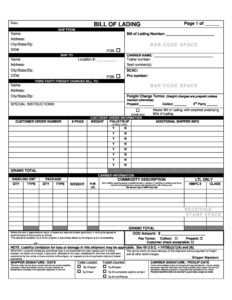In the bustling world of commerce, not every transaction is as straightforward as billing one party and shipping to the exact same address. Sometimes, the complexities of business relationships or specific client needs introduce a fascinating scenario where the company paying the bill is different from the one receiving the goods. This is where the concept of a “bill to ship to” arrangement becomes incredibly important, requiring a clear and precise method to manage these distinct details.
Understanding this separation is crucial for smooth operations, accurate record-keeping, and maintaining professional clarity with all parties involved. Whether you are dealing with drop shipping, gift orders, or instances where a parent company pays for a subsidiary’s order, having the right documentation is key to avoiding confusion and ensuring that everyone is on the same page from start to finish.
Understanding the Nuances of Bill To Ship To Transactions
When you encounter a bill to ship to situation, it essentially means there are two distinct entities involved in the transaction beyond just your own business. There is the “bill to” party, which is the entity responsible for the payment and often the legal contracting party, and then there is the “ship to” party, which is the recipient of the goods or services. This separation necessitates a detailed approach to invoicing that clearly distinguishes between these two sets of information.

Imagine a large corporation purchasing office supplies for several different branch locations. The corporate headquarters might be the “bill to” entity, handling all payments and accounting. However, the supplies themselves are shipped directly to each individual branch office, making each branch a “ship to” destination. Without a proper system to track this, invoices could easily become confusing, leading to payment delays or delivery errors.
This distinction is not just about logistics; it also has significant implications for accounting, tax reporting, and customer service. Accurate identification of both parties on your invoice helps in correctly attributing revenue, managing inventory, and resolving any potential issues quickly. It ensures that the right financial records are maintained for the payer and that delivery confirmations go to the actual receiver of the goods.
Therefore, when you are putting together your invoices for these specific types of sales, it is incredibly important to include dedicated sections for both sets of contact details. This ensures transparency and efficiency throughout the entire order fulfillment and payment process, making life easier for your team and for your customers.
Essential Information for Bill To Ship To Invoices
- Full legal name and contact information of the “Bill To” entity.
- The complete billing address for the “Bill To” entity.
- Any relevant tax identification numbers or purchase order numbers from the “Bill To” entity.
- Full legal name and contact information of the “Ship To” entity.
- The complete delivery address for the “Ship To” entity.
- Specific delivery instructions or recipient contact details for the “Ship To” location.
Crafting Your Perfect Bill To Ship To Invoice Template
Creating a robust bill to ship to invoice template is not just about aesthetics; it is about building a functional document that streamlines your billing process and prevents costly mistakes. A well-designed template provides a clear framework, ensuring that all necessary information is captured consistently for every transaction. This level of organization can significantly reduce administrative overhead and improve cash flow by minimizing invoice disputes.
Your template should be intuitive and easy to populate, whether you are using a simple word processor, a spreadsheet program, or specialized accounting software. The key is to have distinct, clearly labeled sections for both the “Bill To” and “Ship To” details, making it immediately obvious who is paying and who is receiving. Beyond these critical addresses, remember to include all the standard invoice elements like your company details, invoice number, date, due date, itemized list of goods or services, quantities, unit prices, total amount due, and payment terms.
Think about the user experience both for your internal team and for your clients. A cluttered or confusing invoice can lead to delays and questions, while a clean, professional bill to ship to invoice template instills confidence and reflects positively on your business. Consider incorporating your company logo and consistent branding elements to reinforce your professional image.
Ultimately, investing time in developing or sourcing a high-quality bill to ship to invoice template pays dividends in operational efficiency and client satisfaction. It simplifies complex order fulfillment scenarios, ensures financial accuracy, and supports a seamless transaction experience for everyone involved, from initial order to final payment.
- Ensure clear, distinct sections for “Bill To” and “Ship To” information.
- Include all standard invoice elements such as invoice number, date, and itemized list.
- Maintain a professional and uncluttered layout for easy readability.
- Incorporate your company branding for consistency and professionalism.
- Consider adding fields for specific delivery instructions or reference numbers.



